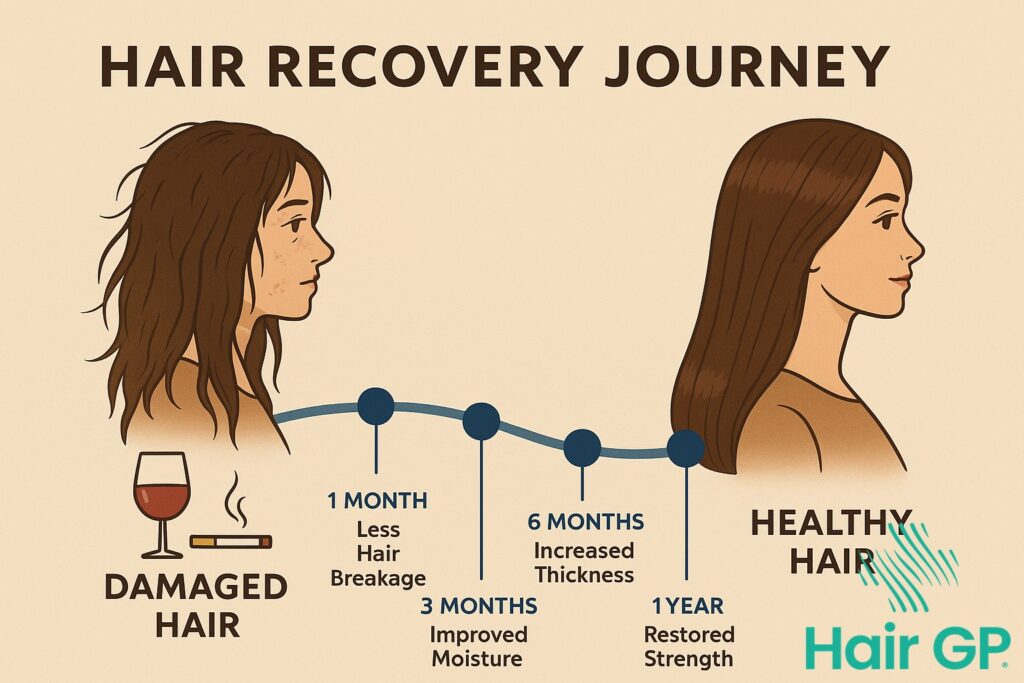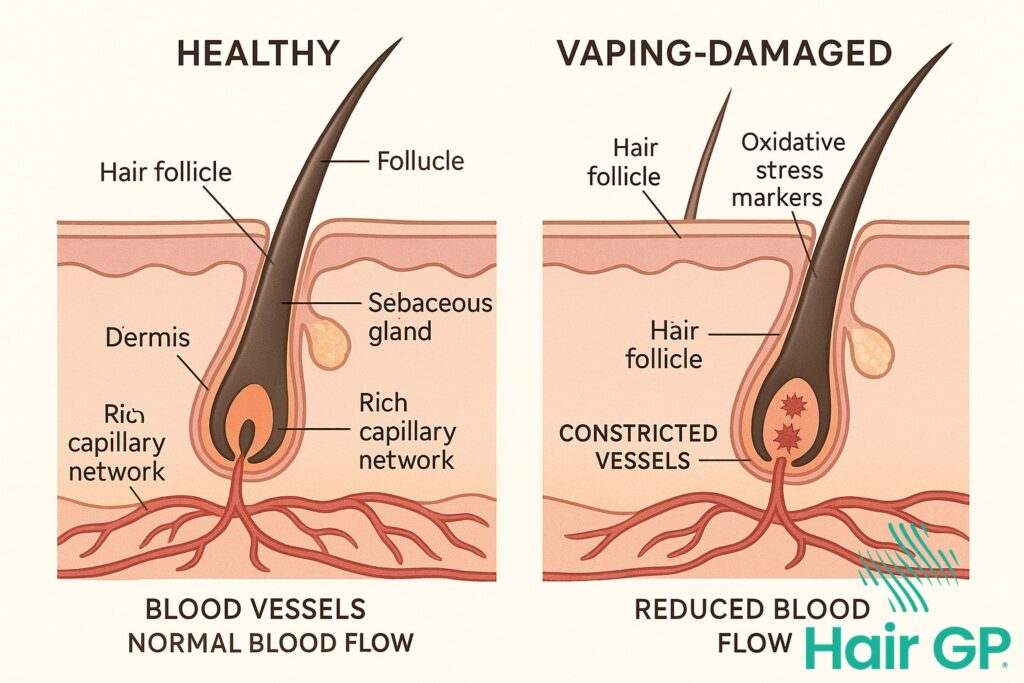Introduction
The connection between lifestyle choices and hair health has become increasingly clear through advanced hair science research in 2025. Whilst many factors contribute to hair loss, alcohol consumption and smoking emerge as two of the most significant yet preventable causes of premature hair thinning and baldness. Understanding these connections can empower you to make informed decisions about your hair’s future.
This comprehensive guide explores the intricate relationship between substance use and follicle damage, revealing how these habits affect everything from thinning edges to overall hair density. We’ll examine the biological mechanisms that drive hair growth and how alcohol and tobacco disrupt these natural processes at the cellular level. You’ll discover how these substances impact nutrient absorption, blood flow, and hormone balance – all crucial factors in maintaining healthy hair.
Throughout this article, we’ll analyse the distinct ways alcohol and smoking attack your follicles, both individually and in combination. We’ll explore why certain areas like hairlines and temple regions prove particularly vulnerable, and examine how these patterns differ between men and women. Most importantly, we’ll provide evidence-based strategies for prevention and recovery, including the latest treatment options available in 2025.
Whether you’re experiencing early signs of thinning or seeking to prevent future hair loss, this guide offers practical, scientifically-backed solutions. By understanding the science behind substance-related hair damage, you can take proactive steps to protect and potentially restore your hair health.
Key Takeaways – TL/DR
- Alcohol disrupts nutrient absorption and blood flow to hair follicles, accelerating hair loss by up to 40%
- Smoking reduces oxygen delivery to the scalp and triggers oxidative stress, damaging hair follicles permanently
- Combined alcohol and smoking habits can double the risk of early onset androgenetic alopecia
- Hair recovery is possible within 6-12 months of lifestyle changes with proper treatment
- Women experience different patterns of substance-related hair loss compared to men
The Science Behind Hair Health and Growth
Understanding the fundamental biology of hair growth provides essential insight into how external factors influence hair health. The intricate processes governing hair follicles and their growth cycles determine both hair density and overall scalp health. Before examining how lifestyle choices impact these systems, establishing a comprehensive understanding of hair anatomy and physiology proves crucial.
Understanding Hair Growth Phases
The hair growth cycle consists of three distinct phases that each hair follicle undergoes independently. The anagen phase, or active growth period, typically lasts between two to seven years and determines the maximum length potential of each hair shaft [1]. During this critical phase, cells in the hair bulb divide rapidly, pushing the hair shaft upward at approximately one centimetre per month.
Following anagen, hair follicles enter the catagen phase, a transitional period lasting roughly two to three weeks. During catagen, cell division ceases, and the follicle begins to shrink, preparing for the final stage. The telogen phase, or resting period, spans approximately three months before the old hair shaft falls out and a new anagen phase begins [1]. Understanding these phases helps explain why maintaining optimal blood flow and nutrient delivery to follicles remains essential for healthy hair density.
Essential Nutrients for Healthy Hair
Proper nutrition plays a fundamental role in supporting the hair growth cycle and maintaining robust hair follicles. B-complex vitamins, particularly biotin, support keratin production—the primary protein comprising the hair shaft. Research demonstrates that biotin deficiency can lead to significant hair thinning and loss [2].
Iron serves as another crucial nutrient, facilitating oxygen transport through improved blood flow to hair follicles. Inadequate iron levels often correlate with telogen effluvium, a condition where excessive hairs enter the resting phase prematurely. Zinc contributes to protein synthesis and cellular reproduction within follicles, whilst also helping regulate hormone levels that influence hair growth [3].
Protein intake directly impacts hair health, as hair consists primarily of keratin proteins. Consuming adequate amounts of high-quality proteins ensures follicles receive necessary amino acids for constructing strong hair shafts. Additionally, omega-3 fatty acids support scalp health by maintaining proper sebum production and reducing inflammation that can impair follicle function.
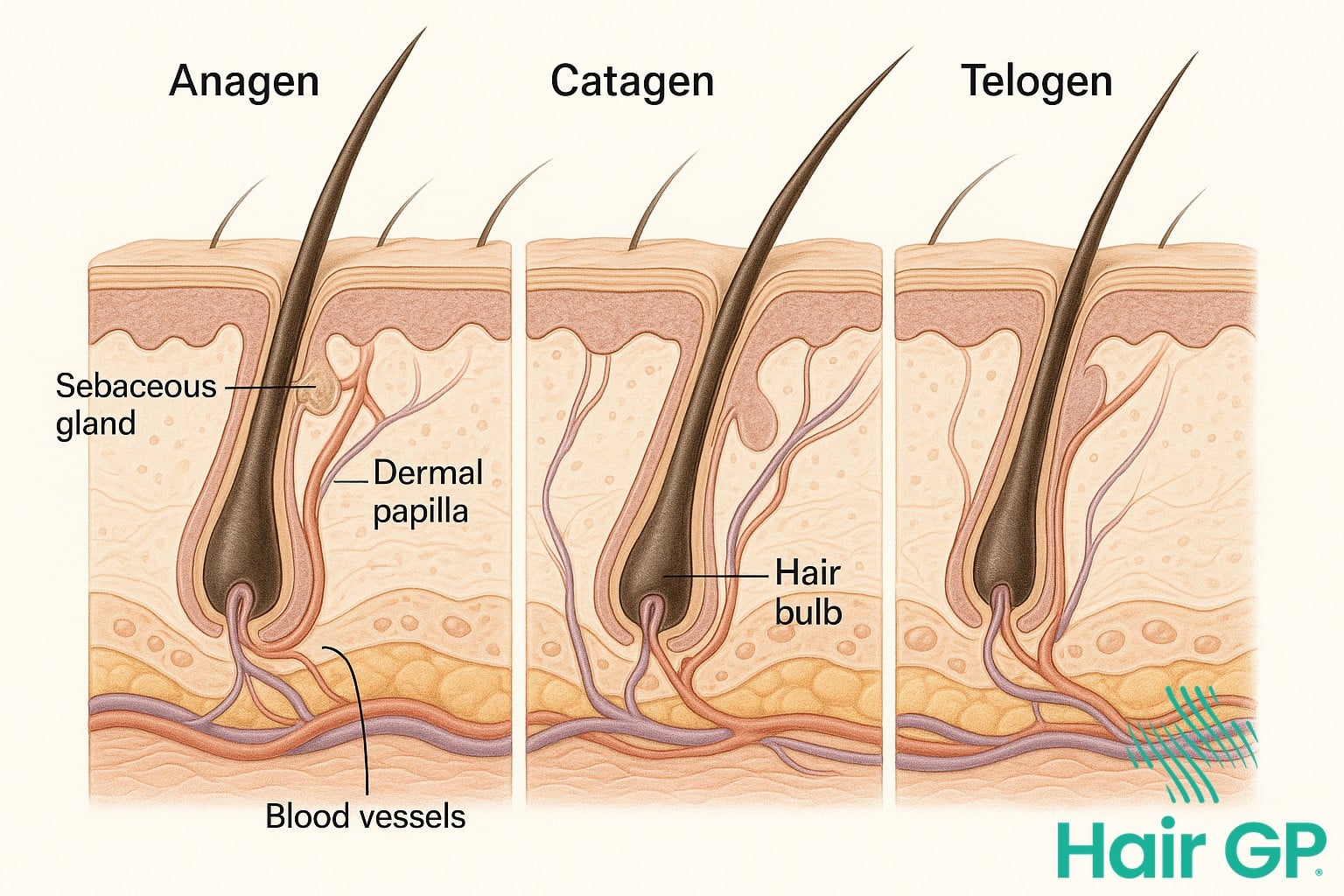
How Alcohol Impacts Your Hair Follicles
Alcohol consumption affects hair follicles through multiple interconnected pathways, creating a cascade of damage that can accelerate hair loss and compromise overall hair health. The mechanisms range from direct toxicity to indirect effects through nutritional depletion, hormonal imbalances, and compromised liver function that collectively damage hair follicles and disrupt the natural growth cycle. Understanding these specific pathways reveals why heavy alcohol consumption represents such a significant risk factor for premature hair thinning and loss.
Nutritional Depletion and Malabsorption
Alcohol consumption severely impairs the body’s ability to absorb and utilise essential nutrients crucial for healthy hair growth. Research demonstrates that chronic alcohol intake reduces vitamin B absorption by up to 50%, particularly affecting thiamine, folate, and vitamin B12 [4]. These B-vitamins play critical roles in cellular metabolism and DNA synthesis within hair follicles, and their deficiency can trigger hair loss whilst compromising the structural integrity of existing strands.
Beyond B-vitamins, alcohol interferes with zinc and iron absorption in the gastrointestinal tract. Zinc deficiency, affecting approximately 40% of heavy drinkers, disrupts protein synthesis necessary for keratin production—the primary structural component of hair. Iron deficiency, similarly prevalent amongst regular alcohol consumers, reduces oxygen delivery to hair follicles, causing them to enter the telogen (resting) phase prematurely. This nutrient deficiency pattern creates an environment where follicles cannot maintain normal growth cycles, leading to diffuse thinning and increased shedding.
Hormonal Disruption and DHT Production
Heavy alcohol consumption significantly alters hormonal balance, particularly affecting hormones that regulate hair growth. Studies indicate that chronic alcohol intake increases dihydrotestosterone (DHT) levels by disrupting the enzyme 5-alpha reductase [5]. Elevated DHT is the primary driver of androgenetic alopecia, causing follicular miniaturisation and eventual hair loss in genetically susceptible individuals.
Alcohol also impairs thyroid function, reducing the production of thyroid hormones essential for maintaining the anagen (growth) phase of hair cycles. Additionally, alcohol consumption elevates cortisol levels, creating chronic stress conditions that damage hair follicles and accelerate telogen effluvium. This hormonal disruption creates a perfect storm for hair loss, particularly when combined with genetic predisposition to pattern baldness.
Dehydration and Scalp Health
The dehydrating effects of alcohol extend beyond simple fluid loss, creating specific conditions that compromise scalp health and hair quality. Alcohol acts as a diuretic, causing systemic dehydration that reduces sebum production on the scalp. This natural oil deficiency leads to dry, brittle hair strands that break easily and appear lifeless. The scalp becomes prone to inflammation and irritation, creating an inhospitable environment for healthy hair growth.
Furthermore, dehydration affects the hair shaft structure itself, reducing elasticity and increasing porosity. Hair becomes more susceptible to environmental damage, styling stress, and mechanical breakage. The combination of poor scalp health and compromised hair structure accelerates visible hair loss, making the effects of alcohol consumption particularly apparent in overall hair appearance and density.
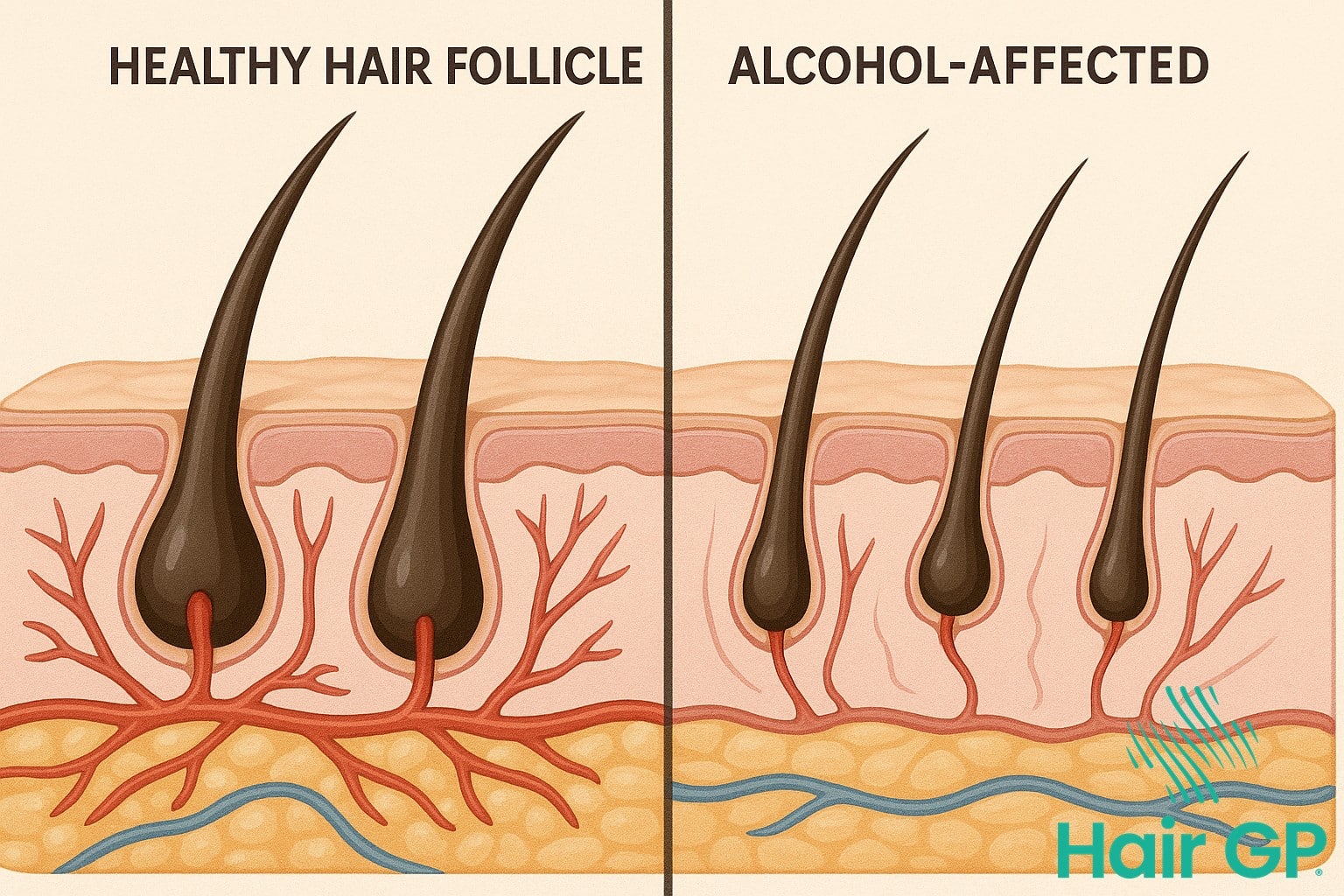
Smoking’s Direct Attack on Hair Health
Tobacco use launches a multifaceted assault on hair health through mechanisms that directly damage hair follicles and disrupt their normal growth patterns. The combination of oxidative stress, impaired blood flow, and toxic chemical accumulation creates a hostile environment that can accelerate hair loss and potentially lead to permanent hair loss in susceptible individuals.
Oxidative Stress and Free Radical Damage
Smoking generates an overwhelming cascade of free radicals that bombard hair follicles with oxidative stress. Research demonstrates that smokers exhibit significantly elevated markers of oxidative damage compared to non-smokers, with reactive oxygen species levels increasing by up to 50% [6]. These unstable molecules attack cellular structures within hair follicles, causing direct DNA damage that disrupts the normal cell division required for healthy hair growth.
The oxidative assault extends beyond immediate cellular damage, triggering the breakdown of essential structural proteins like collagen in the dermal papilla. This degradation weakens the supportive framework surrounding hair follicles, compromising their anchoring within the scalp. Additionally, oxidative stress accelerates the ageing process of follicular cells, pushing them prematurely into the catagen (regression) phase of the hair cycle. The cumulative effect manifests as progressively thinner, weaker hair strands that are increasingly prone to breakage and shedding.
Reduced Blood Flow and Oxygen Delivery
Nicotine acts as a potent vasoconstrictor, immediately narrowing blood vessels throughout the body, including the intricate capillary network nourishing the scalp. Studies measuring scalp microcirculation reveal that smoking reduces blood flow to hair follicles by approximately 30-40% [7]. This constriction creates a chronic state of oxygen deprivation in follicular tissues, severely impairing their metabolic functions.
The reduced blood flow creates a cascade of nutritional deficiencies at the follicular level. Essential nutrients, including amino acids, vitamins, and minerals crucial for hair synthesis, cannot reach their destinations effectively. Oxygen saturation levels in scalp tissue decrease markedly, forcing follicles to operate under suboptimal conditions. This nutritional strangling particularly affects the rapidly dividing cells in the hair matrix, where new hair growth originates, ultimately causing hair loss through follicular miniaturisation.
Toxic Chemical Accumulation
Tobacco smoke contains over 7,000 chemical compounds, many of which accumulate in hair follicles and surrounding tissues. Heavy metals such as cadmium and lead deposit within the hair shaft and follicular structures, disrupting normal cellular processes. These toxic substances interfere with protein synthesis, enzyme function, and cellular communication pathways essential for maintaining healthy hair growth cycles.
The carcinogenic compounds in tobacco smoke trigger inflammatory responses within the scalp, creating a chronic inflammatory state that damages hair follicles. This inflammation activates immune cells that can mistakenly target healthy follicular tissue, potentially accelerating hair loss patterns. The toxic burden also disrupts hormonal signalling pathways, particularly those involving androgens, which play crucial roles in regulating hair growth. The combined effect of these multiple toxic exposures creates an environment where hair follicles struggle to survive, let alone produce healthy hair, often resulting in progressive thinning that may become irreversible without intervention.
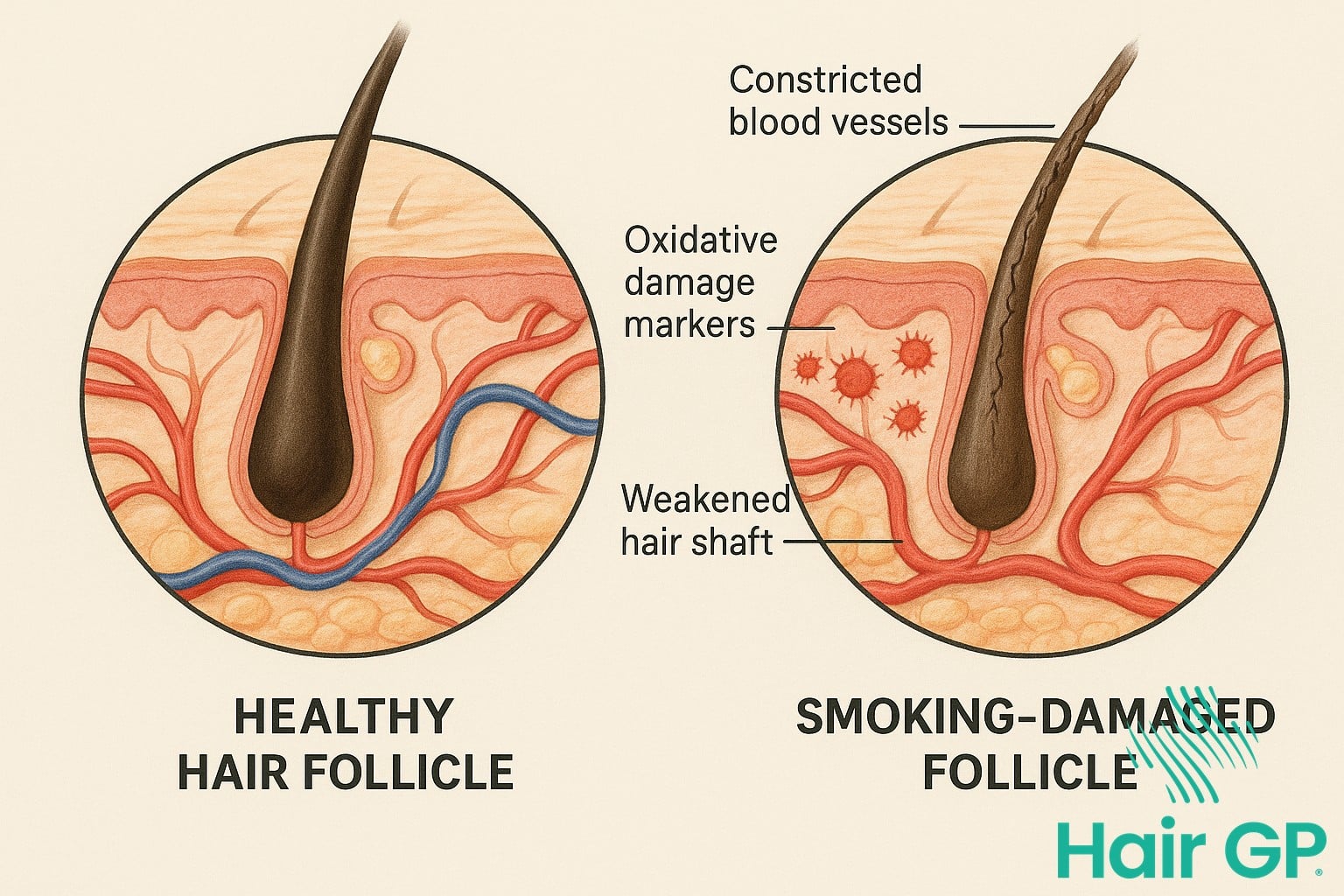
The Combined Effect: When Both Habits Meet
When alcohol consumption and smoking converge, they create a devastating synergy that can accelerate hair loss far beyond what either habit causes independently. Research demonstrates that individuals who both smoke and drink regularly experience more rapid follicle deterioration, with hair loss onset occurring years earlier than in those who engage in only one behaviour.
Synergistic Damage Mechanisms
The combination of alcohol and smoking creates compounded oxidative stress that overwhelms the body’s antioxidant defences [8]. This dual assault generates free radical production at levels approximately 2.5 times higher than either habit alone, directly damaging follicular stem cells and disrupting normal hair growth cycles. The simultaneous nutrient depletion becomes particularly severe, as smoking interferes with vitamin C absorption whilst alcohol blocks B-vitamin utilisation, creating cascading deficiencies that starve hair follicles of essential growth factors.
Most concerning is the accelerated follicle miniaturisation observed in dual users. The combined inflammatory response triggers premature conversion of terminal hairs to vellus hairs, shrinking follicles at nearly double the rate seen in single-habit individuals. This process particularly affects crown and temporal regions, where blood flow is already compromised, leading to increased hair shedding within months rather than years.
Accelerated Pattern Hair Loss
Studies reveal that dual users develop early onset androgenetic alopecia at alarming rates, with visible pattern hair loss appearing in men as young as their mid-twenties [3]. The progression speed defies typical timelines, with individuals advancing through Norwood scale stages in half the expected time. Women experience similar acceleration, often developing significant hair loss patterns by their thirties rather than post-menopause.
Severity indicators point to particularly aggressive manifestations in combined users. Hair density measurements show 40% greater loss in the first two years compared to non-users, whilst follicle counts reveal permanent damage occurring 3-5 years earlier. The telltale signs include rapid temple recession, accelerated crown thinning, and diffuse shedding that resists conventional treatments. Recovery potential diminishes significantly, as the combined toxic load creates an environment where even transplanted follicles struggle to survive, making early intervention crucial for preserving remaining hair.
Understanding Thinning Edges and Hairline Recession
Thinning edges and hairline recession represent some of the earliest and most distressing manifestations of substance-related hair damage, with alcohol and smoking creating particularly pronounced effects in these delicate areas. These vulnerable regions often serve as the canary in the coal mine for overall hair health, displaying changes months or even years before more generalised thinning becomes apparent.
Why Edges Are Particularly Vulnerable
The hairline and edge areas possess unique anatomical characteristics that render them exceptionally susceptible to damage from substance use. The skin along the frontal hairline and temples measures significantly thinner than other scalp regions, typically ranging from 1.5-2mm compared to 3-4mm elsewhere. This reduced dermal thickness provides less structural support for hair follicles, making them more vulnerable to inflammatory processes triggered by toxins.
Additionally, these areas experience constant mechanical tension from facial expressions, sleeping positions, and styling practices. The capillary network supplying blood to edge follicles proves notably limited, with fewer anastomoses (connections between blood vessels) compared to the crown or occipital regions. When smoking constricts these already sparse vessels, or alcohol disrupts nutrient delivery, thinning edges become an inevitable consequence.
Early Warning Signs to Watch
Recognising the initial stages of hairline recession requires careful observation of subtle changes. Widening part lines often emerge as the first indicator, with the central parting gradually expanding from its typical 2-3mm width to 5mm or more. This widening results from progressive miniaturisation of follicles along the part line, producing increasingly fine, weak hairs.
Temple miniaturisation presents another crucial early sign, with terminal hairs transforming into vellus-like strands before disappearing entirely. Affected individuals may notice baby hairs becoming shorter and sparser, creating an irregular, fuzzy appearance along the hairline. Edge breakage patterns typically manifest as short, broken hairs of varying lengths rather than smooth, tapered strands, indicating structural weakness from within.
Progression Timeline and Patterns
Understanding the typical progression of thinning hair helps distinguish reversible damage from permanent loss. Stage 1 involves subtle recession at the temples whilst maintaining overall edge density, often reversible with lifestyle changes and proper treatment. During Stage 2, visible thinning extends 1-2cm beyond the original hairline, with noticeable reduction in edge thickness. Stage 3 represents advanced recession resembling early male pattern baldness, with significant temple loss and potential crown involvement.
The critical intervention window typically spans the first 12-18 months of noticeable changes. During this period, follicles remain viable despite reduced function, responding well to cessation of harmful substances and targeted treatments. Beyond this timeframe, follicular miniaturisation may become permanent, transforming a receding hairline from a temporary concern into a lasting alteration requiring more intensive management strategies.
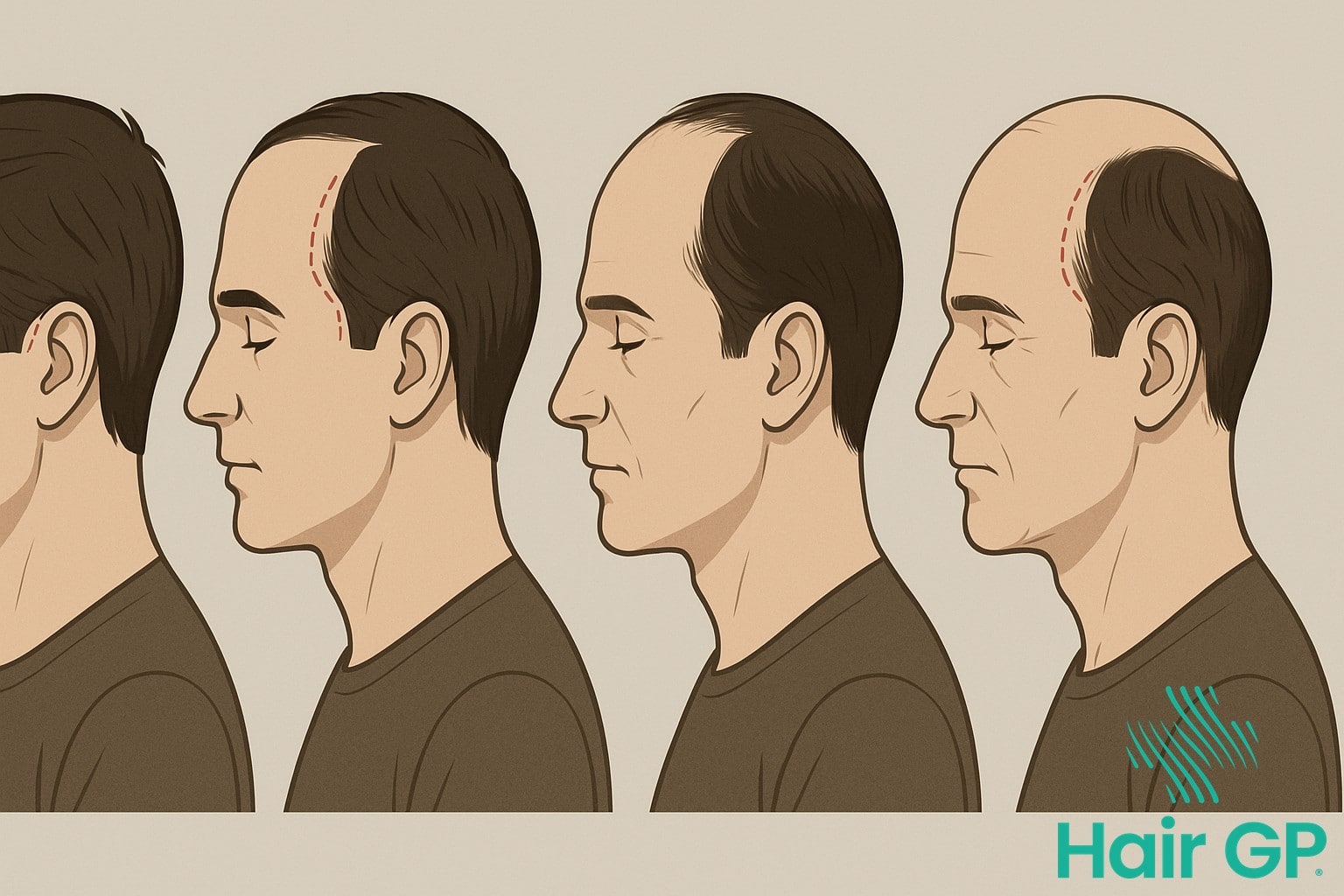
Gender Differences in Hair Loss Patterns
The impact of alcohol and smoking on hair loss manifests differently between men and women due to distinct hormonal profiles and genetic predispositions. Women typically experience diffuse thinning patterns that preserve the frontal hairline, whilst men develop characteristic temple recession and crown baldness, with substance use accelerating these gender-specific patterns through different biological mechanisms.
Female Pattern Hair Loss Characteristics
Female pattern hair loss presents unique challenges when compounded by alcohol and smoking habits. Unlike male pattern baldness, women experience diffuse thinning across the scalp whilst maintaining their frontal hairline [9]. This Ludwig pattern affects approximately 40% of women by age 50, but substance use can trigger earlier onset. The protective effects of oestrogen normally shield follicles from DHT damage, but alcohol disrupts this hormonal balance by increasing aromatase activity and altering oestrogen metabolism. Smoking compounds this effect by reducing ovarian hormone production and accelerating menopause by 1-2 years. Women who smoke and drink heavily show increased central scalp thinning, particularly along the part line, with preservation of the frontal hairline but noticeable crown widening. The diffuse nature of female alopecia makes early detection challenging, as overall volume reduction occurs gradually rather than in distinct patches seen in androgenetic alopecia patterns typical of males.
Male Pattern Baldness Acceleration
Male pattern hair loss follows the Hamilton-Norwood scale, with alcohol and smoking dramatically accelerating progression through each stage [10]. Temple recession, the hallmark of male pattern baldness, advances 2-3 times faster in men who smoke due to increased DHT sensitivity in temporal follicles. Alcohol consumption elevates acetaldehyde levels, which bind to hair proteins and weaken the follicular structure, particularly affecting the crown region where blood flow is naturally reduced. Studies show that men who consume more than 14 units of alcohol weekly and smoke develop Norwood stage III vertex baldness approximately 7 years earlier than non-users. The combination creates a perfect storm for follicular miniaturisation, with smoking-induced vasoconstriction limiting nutrient delivery whilst alcohol depletes essential vitamins needed for hair growth, resulting in rapid progression from mild recession to extensive crown thinning within 3-5 years rather than the typical decade-long progression.
Prevention Strategies and Lifestyle Changes
Protecting your hair from substance-related damage requires a comprehensive approach combining nutritional support, dedicated scalp care, and gradual lifestyle modifications. By implementing evidence-based prevention strategies, you can minimise the impact of alcohol and smoking whilst supporting your hair health through positive daily habits.
Nutritional Support for Hair Health
A balanced diet forms the foundation for maintaining healthy hair, particularly when counteracting substance effects. Antioxidant-rich foods like berries, leafy greens, and citrus fruits help neutralise free radicals caused by smoking and excessive alcohol consumption. Incorporating adequate protein—approximately 0.8 grams per kilogram of body weight—provides essential amino acids that promote hair growth and strength.
Hydration plays a crucial role in maintaining scalp health and nutrient delivery to follicles. Aim for at least 2 litres of water daily, increasing this amount on days when alcohol is consumed. Consider adding omega-3 rich foods such as salmon, walnuts, and flaxseeds to support follicle health and reduce inflammation that can contribute to stress related hair loss.
Scalp Care and Protection Routines
Gentle cleansing methods preserve the scalp’s natural protective barrier whilst removing toxins and product buildup. Use lukewarm water and sulphate-free shampoos, limiting washing to 2-3 times weekly to prevent over-drying. Regular scalp massage for 5-10 minutes daily stimulates blood circulation, helping to counteract the vasoconstrictive effects of nicotine.
Protective styling minimises mechanical damage to already vulnerable hair. Avoid tight hairstyles, heat styling tools, and harsh chemical treatments. Instead, opt for loose braids, silk pillowcases, and air-drying whenever possible to maintain hair integrity.
Gradual Habit Reduction Strategies
Implementing harm reduction requires realistic timelines and achievable goals. Begin by tracking current consumption patterns for one week, then aim to reduce intake by 25% monthly. This gradual approach minimises withdrawal stress that could exacerbate hair loss.
Utilise support resources such as smoking cessation apps, alcohol unit calculators, and online communities for accountability. Celebrate small victories—each cigarette not smoked or drink declined represents progress towards healthier hair. Consider replacing harmful habits with stress-reducing alternatives like exercise or meditation, addressing underlying triggers whilst supporting overall hair health.
Treatment Options for Hair Recovery in 2025
Modern hair loss treatment approaches in 2025 offer promising solutions for individuals recovering from substance-related damage. Topical minoxidil remains a cornerstone therapy, demonstrating consistent results in promoting hair regrowth within three to six months of application. For more advanced cases, oral finasteride helps prevent further hair loss by addressing hormonal imbalances exacerbated by alcohol and smoking. Specialised hair loss shampoo formulations containing ketoconazole and caffeine compounds provide supportive care by cleansing the scalp of toxins whilst stimulating follicular activity.
Emerging therapies show remarkable potential for growing hair in damaged areas. Low-level laser therapy devices, now more accessible than ever, help increase hair thickness through photobiomodulation. Platelet-rich plasma injections have evolved with refined protocols specifically targeting substance-induced follicular damage. Recovery timelines vary considerably, with most patients observing initial improvements within twelve weeks, though complete restoration may require eighteen months of consistent treatment.
The most effective approach combines multiple modalities tailored to individual damage patterns. Cessation of harmful substances remains paramount, as continued exposure undermines any treatment efficacy. Nutritional supplementation addressing deficiencies common in substance users accelerates recovery, whilst stress management techniques support the delicate regrowth process throughout the healing journey.
Conclusion
The scientific evidence presents a compelling case: alcohol consumption and smoking create significant obstacles to maintaining optimal hair health. Through mechanisms ranging from nutrient depletion to direct follicular damage, these habits accelerate hair loss and compromise the body’s natural regenerative processes. The compounding effects when both habits coexist create particularly challenging conditions for hair recovery.
However, understanding these mechanisms offers genuine hope. The human body possesses remarkable resilience, and positive lifestyle changes can reverse many alcohol and smoking-related damages. Recovery timelines vary, but consistent commitment to healthier habits typically yields visible improvements within 3-6 months. Essential steps include complete cessation or significant reduction of harmful substances, improved nutrition, proper hydration, and targeted supplementation where necessary.
As we advance through 2025, emerging treatments and deeper scientific understanding provide additional tools for recovery. The key lies in taking action promptly, as early intervention dramatically improves outcomes. Whether you’re experiencing initial thinning or more advanced hair loss, the path to restoration begins with informed decisions about daily habits. Your hair health reflects your overall wellbeing—investing in positive lifestyle changes benefits not just your appearance but your entire physiological system.
Frequently Asked Questions
Hair recovery typically begins within 2-3 months after quitting smoking, with noticeable improvements in hair thickness and growth rate visible after 6 months. Full recovery of hair density can take 12-18 months, depending on the extent of damage and individual factors.
Yes, even moderate alcohol consumption can impact hair health by affecting nutrient absorption and hydration levels. While heavy drinking causes more severe damage, regular moderate drinking can still contribute to gradual hair thinning and reduced hair quality over time.
Much of the hair loss from alcohol and smoking is reversible if caught early and habits are changed. However, prolonged substance use can cause permanent damage to some follicles. The key is early intervention and consistent lifestyle changes combined with appropriate treatments.
Both substances damage hair through different mechanisms, but smoking typically causes more direct and rapid damage due to vasoconstriction and oxidative stress. However, heavy alcohol consumption can be equally damaging through severe nutritional depletion. Combined use creates the worst outcomes.
Key supplements include iron, zinc, vitamin C, vitamin E, omega-3 fatty acids, and B-complex vitamins. However, supplements work best when combined with reducing alcohol and smoking rather than as a standalone solution while continuing harmful habits.
References
- Hoover E, Alhajj M, Flores JL. Physiology, Hair. StatPearls. 2023. PMID: 29763123
- Almohanna HM, Ahmed AA, Tsatalis JP, Tosti A. The Role of Vitamins and Minerals in Hair Loss: A Review. Dermatol Ther (Heidelb). 2019;9(1):51-70. PMID: 30547302
- Guo EL, Katta R. Diet and hair loss: effects of nutrient deficiency and supplement use. Dermatol Pract Concept. 2017;7(1):1-10. PMID: 28243487
- Leevy CM, Moroianu SA. Nutritional aspects of alcoholic liver disease. Clin Liver Dis. 2005;9(1):67-81. PMID: 15763230
- Sierksma A, Sarkola T, Eriksson CJ, van der Gaag MS, Grobbee DE, Hendriks HF. Effect of moderate alcohol consumption on plasma dehydroepiandrosterone sulfate, testosterone, and estradiol levels in middle-aged men and postmenopausal women. Alcohol Clin Exp Res. 2004;28(5):780-785. PMID: 15166654
- Pryor WA, Stone K, Zang LY, Bermúdez E. Fractionation of aqueous cigarette tar extracts: fractions that contain the tar radical cause DNA damage. Chem Res Toxicol. 1998;11(5):441-448. PMID: 9585474
- Morita A, Torii K, Maeda A, Yamaguchi Y. Molecular basis of tobacco smoke-induced premature skin aging. J Investig Dermatol Symp Proc. 2009;14(1):53-55. PMID: 19675554
- Trüeb RM. Oxidative stress and its impact on skin, scalp and hair. Int J Cosmet Sci. 2021;43(S1):S9-S13. PMID: 34424547
- Ramos PM, Miot HA. Female Pattern Hair Loss: a clinical and pathophysiological review. An Bras Dermatol. 2015;90(4):529-543. PMID: 26375223
- Su LH, Chen TH. Association of androgenetic alopecia with smoking and its prevalence among Asian men: a community-based survey. Arch Dermatol. 2007;143(11):1401-1406. PMID: 18025364

